河南科技学院:《食品分析》课程教学课件(PPT讲稿)Chapter 5 Determination of moisture
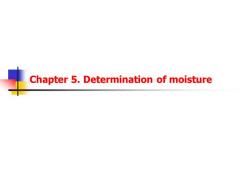
Chapter 5. Determination of moisture
Chapter 5. Determination of moisture
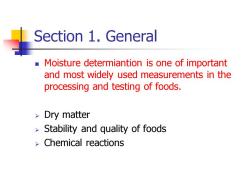
Section 1. General ◼ Moisture determiantion is one of important and most widely used measurements in the processing and testing of foods. ➢ Dry matter ➢ Stability and quality of foods ➢ Chemical reactions
Section 1. General ◼ Moisture determiantion is one of important and most widely used measurements in the processing and testing of foods. ➢ Dry matter ➢ Stability and quality of foods ➢ Chemical reactions
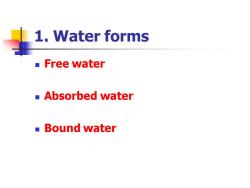
1. Water forms ◼ Free water ◼ Absorbed water ◼ Bound water
1. Water forms ◼ Free water ◼ Absorbed water ◼ Bound water

2. Methods of moisture determination ◼ Direct determinantion: remove the moisture in sample by the methods of drying, distillation and extration. ◼ Indirect detremiantion: using sample’s density, refraction, conductivity or capacitance to measure the moisture content
2. Methods of moisture determination ◼ Direct determinantion: remove the moisture in sample by the methods of drying, distillation and extration. ◼ Indirect detremiantion: using sample’s density, refraction, conductivity or capacitance to measure the moisture content
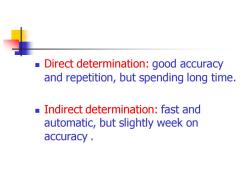
◼ Direct determination: good accuracy and repetition, but spending long time. ◼ Indirect determination: fast and automatic, but slightly week on accuracy
◼ Direct determination: good accuracy and repetition, but spending long time. ◼ Indirect determination: fast and automatic, but slightly week on accuracy

Section 2. Determination of moisture ◼ 1. Drying methods ◼ The procedures for determination the moisture content specified in food standards generally involve thermal drying methods. ◼ The material is heated under carefully specified conditions and the loss of weight is taken as a measure of the moiture content of the sample
Section 2. Determination of moisture ◼ 1. Drying methods ◼ The procedures for determination the moisture content specified in food standards generally involve thermal drying methods. ◼ The material is heated under carefully specified conditions and the loss of weight is taken as a measure of the moiture content of the sample

◼ Drying methods are: ➢ Simple ➢ Relatively rapid ➢ Simultaneous analyses of large numbers of samples
◼ Drying methods are: ➢ Simple ➢ Relatively rapid ➢ Simultaneous analyses of large numbers of samples

Preconditions of drying methods ◼ Water is the only volatile material. ◼ Water can be removed drastically. ◼ During heating, weight loss caused by chemical reactions in other components can be ignored
Preconditions of drying methods ◼ Water is the only volatile material. ◼ Water can be removed drastically. ◼ During heating, weight loss caused by chemical reactions in other components can be ignored

1.1 Directly drying method ◼ Principle: In certain tempatature (95-105℃) and pressure, samples are heated in oven and then water in samples is vaporized. The loss of weight is moisture content of samples. ◼ Applying range: There is no other volatile materials besides water. furthermore, the sample is stable when heating
1.1 Directly drying method ◼ Principle: In certain tempatature (95-105℃) and pressure, samples are heated in oven and then water in samples is vaporized. The loss of weight is moisture content of samples. ◼ Applying range: There is no other volatile materials besides water. furthermore, the sample is stable when heating
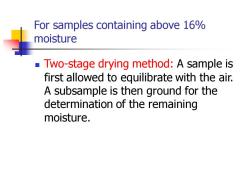
For samples containing above 16% moisture ◼ Two-stage drying method: A sample is first allowed to equilibrate with the air. A subsample is then ground for the determination of the remaining moisture
For samples containing above 16% moisture ◼ Two-stage drying method: A sample is first allowed to equilibrate with the air. A subsample is then ground for the determination of the remaining moisture
按次数下载不扣除下载券;
注册用户24小时内重复下载只扣除一次;
顺序:VIP每日次数-->可用次数-->下载券;
- 河南科技学院:《食品分析》课程教学课件(PPT讲稿)Chapter 4 Physical measurements of food.ppt
- 河南科技学院:《食品分析》课程教学课件(PPT讲稿)Chapter 3 Sensory test.ppt
- 河南科技学院:《食品分析》课程教学课件(PPT讲稿)Chapter 2 Basic Knowledge of food analysis.ppt
- 河南科技学院:《食品分析》课程教学实验指导.doc
- 河南科技学院:《食品分析》课程教学课件(PPT讲稿)Chapter 1 Food Analysis Exordium.ppt
- 漯河职业技术学院:《肉制品生产技术》课程教学资源(PPT课件)第九章 发酵肉制品.ppt
- 漯河职业技术学院:《肉制品生产技术》课程教学资源(PPT课件)第八章 灌肠类制品.ppt
- 漯河职业技术学院:《肉制品生产技术》课程教学资源(PPT课件)第七章 酱卤制品.ppt
- 漯河职业技术学院:《肉制品生产技术》课程教学资源(PPT课件)第六章 腌腊制品.ppt
- 漯河职业技术学院:《肉制品生产技术》课程教学资源(PPT课件)第五章 肉制品加工辅料.ppt
- 漯河职业技术学院:《肉制品生产技术》课程教学资源(PPT课件)第四章 肉类加工生产安全控制与卫生管理.ppt
- 漯河职业技术学院:《肉制品生产技术》课程教学资源(PPT课件)第三章 肉的食用品质及其评定.ppt
- 漯河职业技术学院:《肉制品生产技术》课程教学资源(PPT课件)第二章 原料肉的保鲜储藏.ppt
- 漯河职业技术学院:《肉制品生产技术》课程教学资源(PPT课件)第一章 肉用畜禽.ppt
- 漯河职业技术学院:《肉制品生产技术》课程教学资源(PPT课件)第十四章 肉类罐头.ppt
- 漯河职业技术学院:《肉制品生产技术》课程教学资源(PPT课件)第十三章 油炸肉制品.ppt
- 漯河职业技术学院:《肉制品生产技术》课程教学资源(PPT课件)第十二章 西式火腿制品.ppt
- 漯河职业技术学院:《肉制品生产技术》课程教学资源(PPT课件)第十一章 干肉制品.ppt
- 漯河职业技术学院:《肉制品生产技术》课程教学资源(PPT课件)第十章 烟熏肉制品.ppt
- 广东轻工职业技术大学:《食品理化检验技术》课程教学资源(PPT课件)第九章 食品中功能性成分的检测.ppt
- 河南科技学院:《食品分析》课程教学课件(PPT讲稿)Chapter 6 Ash and minerals.ppt
- 河南科技学院:《食品分析》课程教学课件(PPT讲稿)Chapter 7 Determination of acidity.ppt
- 河南科技学院:《食品分析》课程教学课件(PPT讲稿)Chapter 8 Determination of lipids.ppt
- 河南科技学院:《果蔬食品工艺学》课程教学资源(PPT课件)绪言(主讲:高晗).ppt
- 河南科技学院:《果蔬食品工艺学》课程教学资源(PPT课件)第一章 果蔬加工原料的预处理.ppt
- 河南科技学院:《果蔬食品工艺学》课程教学资源(教案讲义)第一章 果蔬加工原料的预处理.doc
- 河南科技学院:《果蔬食品工艺学》课程教学资源(PPT课件)第二章 果蔬干制.ppt
- 河南科技学院:《果蔬食品工艺学》课程教学资源(教案讲义)第二章 果蔬的干制.doc
- 河南科技学院:《果蔬食品工艺学》课程教学资源(PPT课件)第三章 果品蔬菜罐藏.ppt
- 河南科技学院:《果蔬食品工艺学》课程教学资源(PPT课件)第四章 果品蔬菜糖制.ppt
- 河南科技学院:《肉制品工艺学》课程教学资源(PPT课件)第一章 肉的结构及特性.ppt
- 河南科技学院:《肉制品工艺学》课程教学资源(PPT课件)第二章 畜禽的屠宰及分割.ppt
- 河南科技学院:《肉制品工艺学》课程教学资源(PPT课件)第四章 肉的冷藏.ppt
- 河南科技学院:《肉制品工艺学》课程教学资源(PPT课件)第五章 肉品加工常用的辅料及特性.ppt
- 河南科技学院:《肉制品工艺学》课程教学资源(PPT课件)第六章 腌腊制品.ppt
- 河南科技学院:《肉制品工艺学》课程教学资源(PPT课件)第七章 干肉制品.ppt
- 河南科技学院:《肉制品工艺学》课程教学资源(PPT课件)第八章 酱卤制品.ppt
- 河南科技学院:《肉制品工艺学》课程教学资源(PPT课件)第九章 香肠类制品.ppt
- 河南科技学院:《乳制品工艺学》课程教学资源(PPT课件)绪论(主讲:牛生洋).ppt
- 河南科技学院:《乳制品工艺学》课程教学资源(PPT课件)第十章 乳粉的生产.ppt
